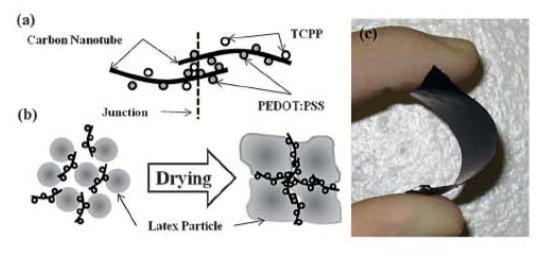Organic thermoelectric nanocomposites
Fully organic thin film nanocomposites were investigated for their superior electrical properties and thermoelectric behavior (G. P. Moriarty, K. Briggs, B. Stevens, C. Yu, J. C. Grunlan, Energy Technol. 2013, 1, 265-272. ). Meso-tetra(4-carboxyphenyl) porphine (TCPP) and poly(3,4-ethylenedioxythiophene):poly(styrene sulfonate) (PEDOT:PSS) were used as intrinsically and semiconducting stabilizers, respectively. The electrical conductivity (σ) of these dual-stabilizer organic composites increased to approximately 9500 S m−1 as the concentration of both the multiwalled carbon nanotubes (MWNT) and PEDOT:PSS increased. Replacing MWNT with double-walled carbon nanotubes (DWNTs) increased σ and S to approximately 96000 S m−1 and 70 µVK−1, respectively at 40% DWNTs. Combining semiconducting and intrinsically conductive molecules as CNT-stabilizers has led to a power factor that is among the best for a completely organic, free-standing film (≈ 500 µWm−1K−2). These flexible, segregated-network nanocomposites now exhibit properties that rival the more conventional inorganic semiconductors, particularly when normalized by the mass.

- (a) Schematic of carbon nanotubes decorated by PEDOT:PSS and TCPP molecules and the junction formed between them. (b) Schematic depicting the formation of a segregated network composite during polymer coalescence as it dries. (c) Photo of a fully dried, free-standing, flexible composite.
